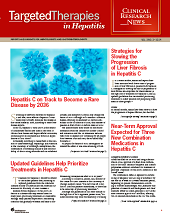Publication
Article
Targeted Therapies: Hepatitis C
Hepatitis C on Track to Become a Rare Disease by 2036
Screening of newborn children for hepatitis C and new, more effective hepatitis C treatments may virtually eliminate the disease in the United States by 2036, according to some liver disease experts.

Screening of newborn children for hepatitis C and new, more effective hepatitis C treatments may virtually eliminate the disease in the United States by 2036, according to some liver disease experts.
In the US, hepatitis C virus (HCV) is the source of considerable health care costs in the form of chronic liver disease and hepatocellular carcinoma, accounting for an estimated $6.5 billion in expenditures in 2011 alone.1,2
Fortunately, according to researchers at the Division of Gastroenterology, Hepatology and Nutrition at the University of Pittsburgh, Pennsylvania, the combination of screening initiatives and the availability of direct-acting antivirals such as sofosbuvir (Sovaldi) and simeprevir (Olysio) may change the future of HCV. Although HCV remains a common disease, affecting an estimated 2.3 million individuals in the US alone as of 2013, that number of patients is down from 3.2 million cases in 2001.1
The authors based their model on the recommendation from the Centers for Disease Control and Prevention and the US Preventive Services Task Force to expand HCV screening for all people born between 1945 and 1965, the so-called baby boomers.1,3,4
To project the future of HCV, investigators estimated the effect of one-time screening of both baby boomers and of children at birth. The authors also accounted for the increased efficacy of antiviral treatments, and based the model on data collected by the National Health and Nutrition Examination Survey between 1999 and 2002.1
Over the next 10 years, with implementation of one-time screening of newborns, investigators estimate that 487,000 cases of HCV infection could be identified and treated. According to investigators, universal screening of all adults would identify 933,700 cases of HCV over the same 10-year period, although universal screening was not a prerequisite of the investigators’ model.1
The investigators suggest that by 2036 the combination of one-time screening at birth and the use of direct-acting antivirals could be expected to transform HCV from the relatively common disease it is today to a rare disease, affecting 1 person in every 1500. Several sensitivity analyses were conducted, all of which predict virtual elimination of HCV by the year 2050.1
It is important to remember that these optimistic predictions hinge on implementation of coverage and screening recommendations. With the availability of new, effective medications that act directly against HCV, dramatic reductions in the prevalence of the disease and its eventual eradication are strong possibilities in the future, these investigators argue.
References
1. Razavi H, Elkhoury AC, Elbasha E, et al. Chronic hepatitis C virus (HCV) disease burden and cost in the United States. Hepatology. 2013;57(6):2164-2170.
2. Kabiri M, Jazwinski AB, Roberts MS, Schaefer AJ, Chhatwal J. The changing burden of hepatitis C virus infection in the United States: model-based predictions. Ann Intern Med. 2014;161(3):170-180.
3. Moyer VA; US Preventive Services Task Force. Screening for hepatitis C virus infection in adults: U.S. Preventive Services Task Force recommendation statement. Ann Intern Med. 2013;159(5):349-357.
4. Smith BD, Morgan RL, Beckett GA, et al. Recommendations for the identification of chronic hepatitis C virus infection among persons born during 1945-1965. [published correction appears in: MMWR Recomm Rep. 2012;61(43):886.]MMWR Recomm Rep. 2012;61(RR-4):1-32.






